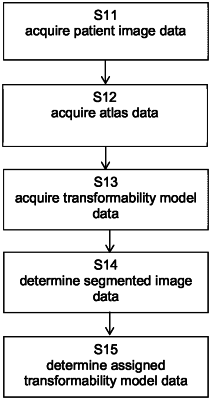| CPC G06T 7/11 (2017.01) [G06T 7/0012 (2013.01); G06T 7/20 (2013.01); G06T 7/70 (2017.01); G06T 2207/20128 (2013.01); G06T 2207/30081 (2013.01)] | 11 Claims |

|
1. A computer-implemented method, comprising:
acquiring patient image data describing a patient image of an anatomical body part of a patient;
acquiring atlas data describing an image-based model of the anatomical body part and at least one value of at least one parameter of a geometric transformability model of the anatomical body part;
acquiring transformability model data describing the geometric transformability model of the anatomical body part or of an image-based representation of the anatomical body part;
determining segmented image data based on the patient image data and the atlas data and the transformability model data, the segmented image data describing a segmentation of the patient image and a geometric relation between the geometric transformability model and the segmentation; and
determining assigned transformability model data based on the segmented image data and the atlas data, the assigned transformability model data describing an assignment of the at least one value of the at least one parameter to the geometric relation between the geometric transformability model and the segmentation,
wherein the geometric transformability model describes a movement interaction between relative positions of disjunct parts, of the image-based model of the anatomical body part, that resemble anatomical structures which are part of the anatomical body part.
|